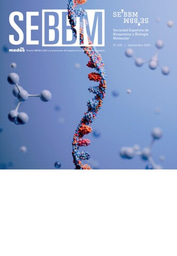
The SEBBM Journal is a channel for analysis, reflection and dissemination of scientific activity in Spain and of public and private research policies. Its origins date back to 1963 and it currently publishes thematic issues covering transversal research in the field of biochemistry and molecular biology. The articles are commissioned by the best specialists in the subject. Each issue also highlights the most relevant educational and scientific work of SEBBM members, as well as SEBBM news.
The current issue “Plants in the face of climate change” (nº 225, June 2025) has been coordinated by Dr. Mariam Sahrawy Barragán from Estación Experimental del Zaidin, CSIC, Spain.
‘Coffee is going to take away our sleep’ was the headline of an article in a national newspaper a few months ago, which, in addition to noting a 23% drop in coffee production in countries such as Brazil and Vietnam, highlighted the global coffee industry's concern about climate change -22 million cups are drunk every day in Spain and world consumption has increased by 5.2%-. Perhaps coffee, on which a large part of the world's population and many countries depend economically, is not the only agricultural product affected by climate change. Cocoa (get ready chocolate addicts!), wheat, maize, rice, bananas and vines are other important crops whose production has been affected.
Some international organisations expect agricultural yields to fall by 30 % over the next 25 years. This is a cause for concern as it affects the world's food supply and leads to higher prices. In this scenario, numerous studies have been devoted to understanding the effects of adverse environmental factors on plants in order to find and provide efficient solutions to avoid crop production losses.
Issue nº 225 of SEBBM Journal includes four articles on the effects of different stresses on plant development, the different responses for plant survival, and the discovery of drugs to increase drought tolerance in agriculture.
José Ángel Mercado and Sara Posé from University of Málaga, in the article 'The impact of climate change on agricultural production’, describe the consequences that climate change can have on agricultural production and identify the effects of different stresses on plant development and the different responses for their survival. Reactive oxygen species (ROS), ABA, regulation of specific genes and transcription factors, among others, are key. As experts, they give a real example of how climate change affects strawberry production in Spain and the Andalusian agricultural economy. https://doi.org/10.18567/sebbmrev_225.202506.dc2
Antonio J. Serrato from Estación Experimental del Zaidin, CSIC, in the article ‘How plants protect their photosynthetic activity in the face of adverse conditions: molecular and physiological strategies’, describe the different adaptive mechanisms developed by plants, including post-translational modifications (PTM) of proteins, the increase in the number of stomata and their different distribution, the biochemical mechanisms of protection of the photosynthetic apparatus and the optimisation of CO2 fixation in C4 or CAM plants subjected to high temperatures. https://doi.org/10.18567/sebbmrev_225.202506.dc3
Myriam Calonje from Institute of Plant Biology and Photosynthesis (IBVF), CSIC-University of Sevilla, in the article ‘Epigenetic regulation of gene expression during plant development and in response to the environment’, writes an interesting review on the subtle role of epigenetic modifications in the ability of plants to resist adverse environmental environments. Methylations, ubiquitinations, phosphorylations or acetylations of DNA or histones are mainly responsible for the specific responses of gene expression to plant needs. The actions implemented in many countries based on the knowledge developed by research are encouraging the emergence of new and promising strategies. https://doi.org/10.18567/sebbmrev_225.202506.dc4
Jorge Lozano-Juste and Carla Donderis-Fagoaga from Institute of Plant Molecular and Cell Biology (IBMCP), UPV-CSIC, Valencia, present in the article ‘Drug discovery to increase drought tolerance in agriculture’ some novel strategies based on the generation of synthetic ABA receptor agonist drugs to address environmental challenges and increase plant resilience to drought. https://doi.org/10.18567/sebbmrev_225.202506.dc5
The issue is available at https://sebbm.es/revista/numeros/plantas-ante-el-cambio-climatico/
Part of this post is a translation of text written in Spanish by Dr. Mariam Sahrawy Barragán from Estación Experimental del Zaidin, CSIC, and published on the SEBBM website on June, 2025.
Reference:
Sahrawy Barragán M. 2025. Las plantas ante el cambio climático. <em>SEBBM</em> 225 https://doi.org/10.18567/sebbmrev_225.202506.dc1





Join the FEBS Network today
Joining the FEBS Network’s molecular life sciences community enables you to access special content on the site, present your profile, 'follow' contributors, 'comment' on and 'like' content, post your own content, and set up a tailored email digest for updates.